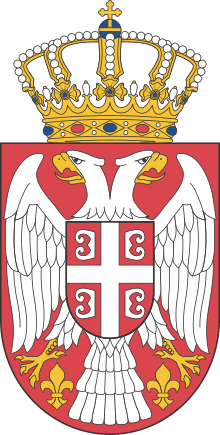Government of Serbia
The Government of Serbia (Serbian: Влада Србије, romanized: Vlada Srbije), formally the Government of the Republic of Serbia (Serbian: Влада Републике Србије, romanized: Vlada Republike Srbije), commonly abbreviated to Serbian Government (Serbian: Српска Влада, romanized: Srpska Vlada), is the executive branch of government in Serbia.
| Government of the Republic of Serbia | |
|---|---|
| Влада Републике Србије Vlada Republike Srbije | |
 | |
| Overview | |
| Established | 29 June 2017 (Current, 15th convocation of the Government of Serbia) 11 February 1991 (1st convocation of the Government of Serbia) |
| State | Republic of Serbia |
| Leader | Prime Minister (nominated by the President of the Republic) |
| Appointed by | National Assembly |
| Ministries | 18 |
| Responsible to | National Assembly |
| Annual budget | €278.71 million (2020, planned)[1] |
| Headquarters | Nemanjina 11, Belgrade |
| Website | www |
 |
|---|
| This article is part of a series on the politics and government of Serbia |
|
|
Legislature
|
|
Judiciary
|
|
|
The affairs of government are decided by the Cabinet of Ministers, which is led by the Prime Minister. The government is housed in a Ministry of Finance of Kingdom of Yugoslavia Building.
Jurisdiction
According to the Constitution of Serbia, the Government:
- Determines and guides policy
- Executes laws and other general acts of the National Assembly
- Adopts regulations and other general acts for the purpose of enforcing laws
- Proposes to the National Assembly the laws and other general acts and gives an opinion on them when submitted by another proposer
- Directs and coordinates the work of public administration bodies and supervises their work
- Performs other duties determined by the Constitution and the law
Also, the Government is responsible to the National Assembly for the policy of the Republic of Serbia, for the implementation of laws and other general acts of the National Assembly and for the work of state administration bodies.
Incumbent government
The incumbent Cabinet was sworn on 29 June 2017 by a majority vote in the National Assembly. It is the first cabinet of Ana Brnabić, who became the Prime Minister month after the former Prime Minister of Serbia Aleksandar Vučić resigned from the office to become the President of Serbia, following the 2017 presidential elections. The current cabinet is in greater part similar to the second cabinet of Aleksandar Vučić and has 21 members (two more than previous cabinet), 18 with a ministry and 3 without portfolio.
List of ministers
Nominating party: SNS SPS n-p (SNS-nominated) SDPS (SNS-nominated) PS (SNS-nominated) SNP (SNS-nominated) PUPS (SNS-nominated)
Government history
List of governments of the Republic of Serbia
| Assumed office | Prime Minister | Party in Office (leading) | Cabinet |
|---|---|---|---|
| 11 February 1991 | Dragutin Zelenović | Socialist Party of Serbia | Cabinet of Dragutin Zelenović |
| 23 December 1992 | Radoman Božović | Cabinet of Radoman Božović | |
| 10 February 1993 | Nikola Šainović | Cabinet of Nikola Šainović | |
| 18 March 1994 | Mirko Marjanović | Cabinet of Mirko Marjanović I | |
| 24 March 1998 | Mirko Marjanović | Cabinet of Mirko Marjanović II | |
| 25 October 2000 | Milomir Minić | Cabinet of Milomir Minić | |
| 25 January 2001 | Zoran Đinđić Zoran Živković | Democratic Opposition of Serbia | Cabinet of Zoran Đinđić |
| 3 March 2004 | Vojislav Koštunica | Democratic Party of Serbia | Cabinet of Vojislav Koštunica I |
| 15 May 2007 | Vojislav Koštunica | Cabinet of Vojislav Koštunica II | |
| 7 July 2008 | Mirko Cvetković | Democratic Party | Cabinet of Mirko Cvetković |
| 27 July 2012 | Ivica Dačić | Serbian Progressive Party | Cabinet of Ivica Dačić |
| 27 April 2014 | Aleksandar Vučić | Cabinet of Aleksandar Vučić I | |
| 11 August 2016 | Aleksandar Vučić | Cabinet of Aleksandar Vučić II | |
| 29 June 2017 | Ana Brnabić | Cabinet of Ana Brnabić |
Governmental agencies and offices
Government of the Republic of Serbia within its ministries has over 130 governmental agencies and institutions.[2][3] These are the services that operate within the Government of the Republic of Serbia (as of December 2017):[4][5]
- Secretary-General Office of the Government of Serbia
- Office for Cooperation with Media
- Agency for human resources management
- Airline service of the Government of Serbia
- Directorate for joint affairs of republic authorities
- Coordination Body for the municipalities of Preševo, Bujanovac and Medveđa
- Office of the National Security and Protection of Classified Informations
- Office for Cooperation with Civil Society
- Audit Office of the European Union Asset Management System
- Office for Human and Minority Rights
- Office for Kosovo and Metohija
- Office for Coordination Affairs in the Negotiation Process with the Provisional Institutions of Self-Government in Priština
- The Office of the Council for Cooperation with the Russian Federation and the People's Republic of China
- Office of Drugs Control
- Public Investment Management Office
- Office of Information Technology and Electronic Administration
See also
References
- "ЗАКОН О БУЏЕТУ РЕПУБЛИКЕ СРБИЈЕ ЗА 2020. ГОДИНУ" (PDF). parlament.gov.rs. Народна скупштина Републике Србије. Retrieved 20 February 2020.
- "Srbija rekorder u broju agencija" (in Serbian). B92. 17 December 2011.
- "Republičke agencije, zavodi i druge organizacije" (in Serbian).
- "Година LXXIII – број 61". pravno-informacioni-sistem.rs (in Serbian). Službeni glasnik RS. 23 June 2017. Retrieved 18 December 2017.
- "ODLUKA O MAKSIMALNOM BROJU ZAPOSLENIH NA NEODREĐENO VREME U SISTEMU DRŽAVNIH ORGANA, SISTEMU JAVNIH SLUŽBI, SISTEMU AUTONOMNE POKRAJINE VOJVODINE I SISTEMU LOKALNE SAMOUPRAVE ZA 2017. GODINU". paragraf.rs (in Serbian). Službeni glasnik RS.
External links
| Wikimedia Commons has media related to Government of Serbia. |